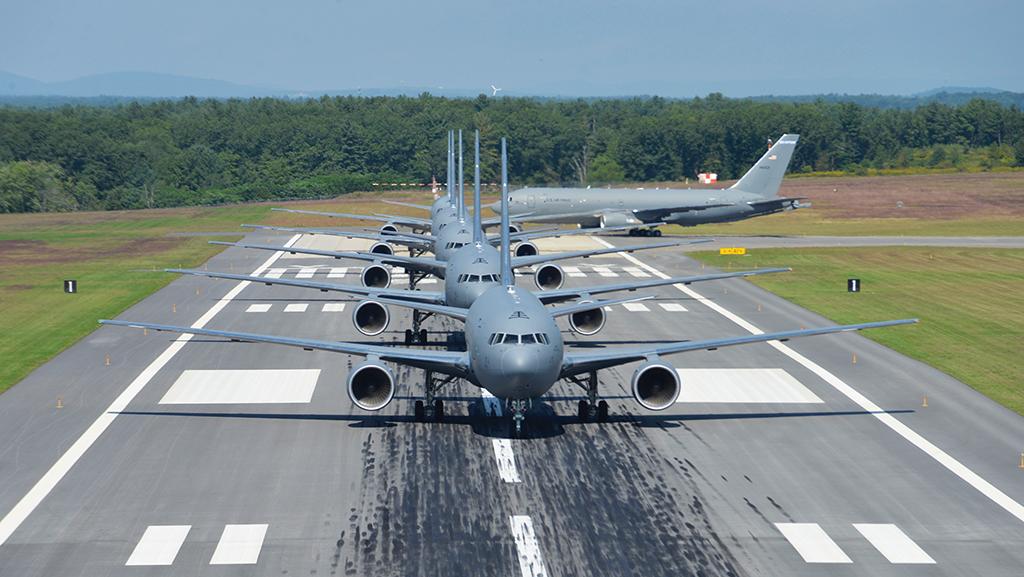This article is published in Aviation Week & Space Technology and is free to read until Aug 15, 2024. If you want to read more articles from this publication, please click the link to subscribe.
Red Ink Tops $16 Billion On Risky USAF Fixed-Price Defense Deals

Losses on Boeing’s fixed-price KC-46 development and procurement contracts now total more than $7 billion since the contract was awarded in 2011.
On July 9, 2014, the U.S. Air Force asked two companies to make a billion-dollar bet on the price of a B-21 Raider bomber in 2024.
That was the day the service’s solicitation for the long-awaited Long-Range Strike Bomber defined the terms of a high-stakes evaluation and called for Northrop Grumman and a Boeing-Lockheed Martin team to submit competing bids. As part of a calculated strategy to emphasize the lowest-cost bidder in a hybrid, technically acceptable/best-value evaluation strategy, the Air Force also demanded that both companies commit to pricing terms 9-13 years into the future, including fixed-price options for the first four lots of production and a not-to-exceed bill for the fifth.
- New rule imposes limits but allows unlimited Pentagon waivers
- AIA CEO warns that fixed-price deals could limit future competition
In the end, Northrop won the prized B-21 contract—and lost its billion-dollar bet. Due to inflation that was higher than expected and supply chain troubles, the company predicts it will lose at least $1.56 billion on the first five production lots for the new bomber. If the Air Force’s 2015 estimate of ordering 21 B-21s during that period stands, Northrop could lose $74 million on average each time a bomber rolls off the assembly line through the end of the decade.
The OEM’s losses add to mounting industry frustration with long-term, fixed-price bids imposed by the Defense Department and NASA. On only eight programs awarded since 2011 the government’s strategy risks costing the three aerospace and defense heavyweights—Boeing, Lockheed and Northrop—almost $16.2 billion in real and potential losses, led by a $13.4 billion tally of reach-forward losses reported by Boeing across five programs, an Aviation Week review of financial filings shows (see table).
In the past year, greater wariness of the financial risks posed by long-term, fixed-price agreements prompted changes in industry behavior, congressional legislation and a change to the Pentagon’s acquisition regulations. Despite—or perhaps encouraged by—the increasingly hostile reaction of traditional defense prime contractors, government officials are not backing down.
“In general, once we get into production, fixed-price is probably the right way to go,” Air Force Secretary Frank Kendall, a longtime military acquisition leader, tells Aviation Week.
The industry’s top lobbying organizations are demanding change. With fixed-price terms during the engineering and manufacturing development phase now largely off the table, these groups want to limit industry’s exposure to the risks of expected inflation or other cost pressures for the first several lots of low-rate initial production.
“Where we’re seeing problems is when the department transitions a company to a fixed-price contract too early, where the technology hasn’t matured to a point where we really understand what it is going to cost over time. And, you know, that’s risky for both sides,” Aerospace Industries Association CEO Eric Fanning told reporters in mid-May.
Sympathetic lawmakers stepped in two years ago. The National Defense Authorization Act of 2023 requires the Pentagon to limit requirements for fixed-price options in contracts to the first year of low-rate initial production. In April, the Defense Department finalized a new rule in the Defense Federal Acquisition Regulation book. However, the rule allows the Pentagon to waive the limit, and defense officials rejected a proposal by industry to set guidelines on when it is appropriate to exercise the waiver authority.
“Providing examples of factors to consider in determining whether or not to waive the limitation may preclude the consideration of factors that are relevant to the instant acquisition and may have a negative impact on meeting mission needs,” says the Pentagon’s final rule, published April 25.
So far, none of the eight programs tracked by Aviation Week appear at risk of cancellation, although several have experienced lengthy development delays and production quantity deferrals. But in some cases, industry is voting with its feet. The Air Force, for example, disqualified Boeing last December from a competition for the Survivable Airborne Operations Center due partly to an unresolved dispute on fixed-price elements of the program’s acquisition strategy. Northrop and Lockheed executives have pledged to avoid deals with the Pentagon that present excessive, long-term risk.
“At the present time, inflation rates are not all that high, and they’re manageable,” Kendall says. “And we do have inflation numbers that are given to us as we build our budgets that are baked into our request. So right now, I don’t see inflation as a huge [cost] driver. That’s not the source of my issues right now, in terms of trying to fund the things we need to do.”
The Pentagon’s strategy has served program budgets well. As losses mounted on two classified Lockheed contracts awarded in the past decade, the Air Force avoided the consequences of contract awards that link payments to industry’s actual costs, freeing up to $1.6 billion in potential company losses for other priorities.
In Fanning’s view, that strategy may work in the government’s favor in the short term, but imposes new risks over time as industry executives adjust their behavior.
“If you squeeze enough of these companies and cause them to not want to engage in certain types of contract vehicles,” Fanning said, “then you end up in a situation where you don’t have the competition you want as you’re trying to bid something.”







Comments